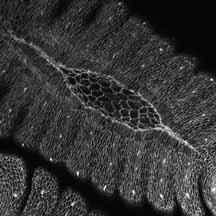Andrew Spracklen Alumni Page
Background & Contact Information
Currently: Lecturer in Biology
UMass Amherst
aspracklen@umass.edu
Postdoc (2014 – 2019)
Education: Ph.D., University of Iowa 2014 (Advisor, Tina Tootle)
Fellowships & Awards: Lineberger Cancer Center Postdoctoral Training Grant (2014-present)
Email: asprack@email.unc.edu
DOWNLOAD CV

Research Information
Defining the mechanisms of regulation of actin polymerization during morphogenesis
The ability of cells to self-assemble into organs is extraordinary and requires tight coordination between the cell machinery modulating adhesion and the cytoskeleton. Defects in this coordination contribute to diseases ranging from developmental defects to cancer; thus it is critical to understand the mechanisms by which coordination of changes in cell adhesion and the actin cytoskeleton is achieved. One factor that regulates this is Abelson tyrosine kinase (Abl). Abl is both a key oncogene and developmental regulator, which functions to link receptors, small adaptor proteins, and cytoskeletal regulators. Three models for Abl function currently exist: 1) Abl phosphorylates protein targets, thus altering their function and influencing cell behavior, 2) Abl directly modulates cytoskeletal dynamics through its conserved C-terminal actin binding domain (FABD), and 3) Abl acts as a scaffold to assemble multi-protein signaling complexes. However, the importance of each role during morphogenesis remains untested.
Using Drosophila embryogenesis as a model, I am working to distinguish between these models by defining how specific functional domains (e.g., kinase activity, F-actin binding, or motifs involved in protein-protein interactions) contribute to Abl’s roles in embryonic morphogenesis. Recently, we have found that specific functional domains differentially affect distinct morphogenic events ranging from epithelial morphogenesis to central nervous system patterning, suggesting that Abl functions as a robust regulatory machine during morphogenesis, with different aspects of its mechanisms of action (e.g., kinase activity, FABD domain, binding partners, etc.) being differentially important for certain biological processes. The overall goal of my work is to define how Abl and its interacting partners regulate cell adhesion and actin dynamics in a normal developmental context. Insight gained from this work will provide new clues as to how Abl works to regulate dynamic cell behaviors during human development and diseases, including cancer.
Publications
- Spracklen, A.J., Thornton-Kolbe, E.M., Bonner, A,N., Florea, A., Compton, P.J., Fernandez-Gonzalez, R., and Peifer, M. (2019). The Crk adapter protein is essential for Drosophila embryogenesis where it regulates multiple actin-dependent morphogenic events. Molecular Biology of the Cell 30, 2399-2421.
- Tootle, T.L. Hoffman, D.S., Allen, A.K., Spracklen, A.J., Groen, C.M., and Kelpsch, D.J. (2019). Research and Teaching: Mini-Course-Based Undergraduate Research Experience: Impact on Student Understanding of STEM Research and Interest in STEM Programs. Journal of College Science Teaching 48,
- Rogers, E.M., Spracklen, A.J., Bilancia, C.G., Sumigray, K.D., Allred, S.C., Nowotarski, S.N., Schaefer, K. N., Ritchie, B.J., and Peifer, M. (2016). Abelson kinase acts as a robust, multifunctional scaffold in regulating embryonic morphogenesis. Molecular Biology of the Cell 27, 2613-2631.
- Spracklen, A.J., and Peifer, M. (2015). Actin and Apical Constriction: Some (Re)-Assembly Required. Developmental Cell 35, 662-4
- Groen, CM*, Spracklen, AJ*, Fagan, TN & Tootle, TL. (2012) Drosophila Fascin is a novel downstream target of prostaglandin signaling during actin remodeling. Mol. Biol. Cell 23, 4567-4578, doi:10.1091/mbc.E12-05-0417 . * Denotes shared first authorship
- Spracklen, AJ & Tootle, TL. (2013) The Utility of Stage-specific Mid-to-late Drosophila Follicle Isolation. Journal of visualized experiments : JoVE, doi:10.3791/50493 .
- Spracklen, AJ, Kelpsch, DJ, Chen, X, Spracklen, CN & Tootle, TL. (2014) Prostaglandins temporally regulate cytoplasmic actin bundle formation during Drosophila oogenesis. Mol. Biol. Cell 25, 391-411, doi:10.1091/mbc.E13-07-0366 . [Selected for the cover of the February 1, 2014 issue]
- Spracklen, AJ, Fagan, TN, Lovander, K, and Tootle, TL. (2014) The pros and cons of common actin labeling tools for visualizing actin dynamics during Drosophila oogenesis. Dev Biol 393, 209-226, doi:10.1016/j.ydbio.2014.06.022 .



